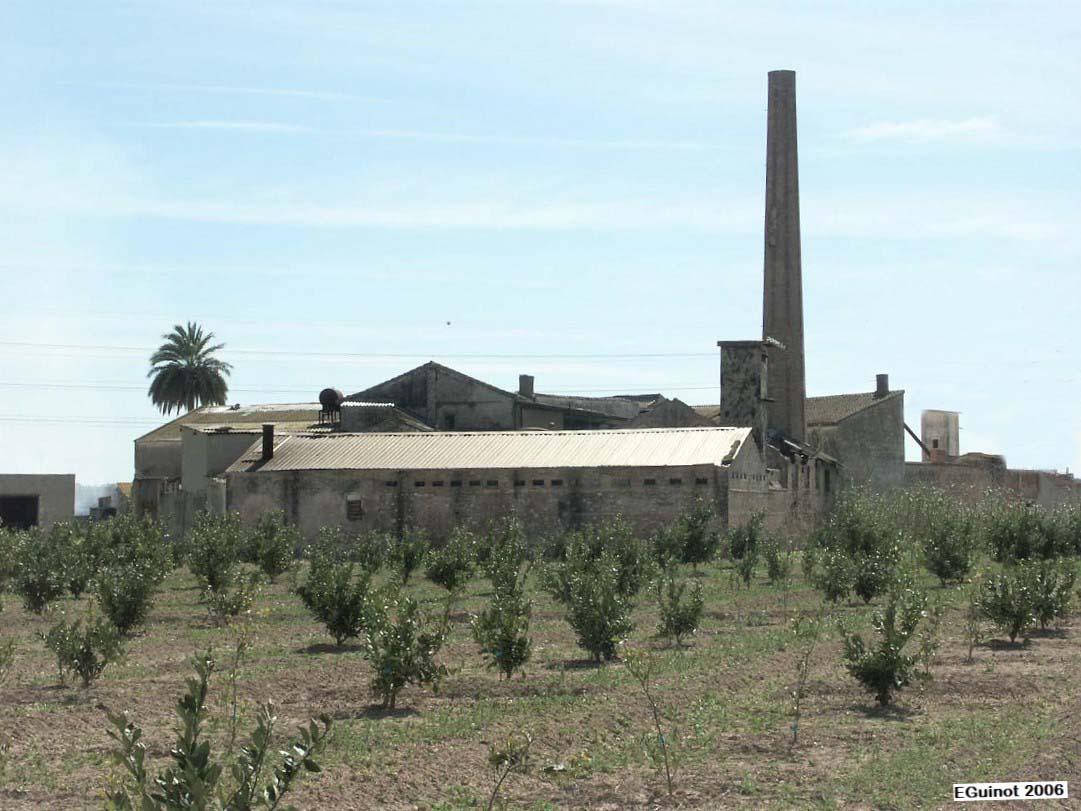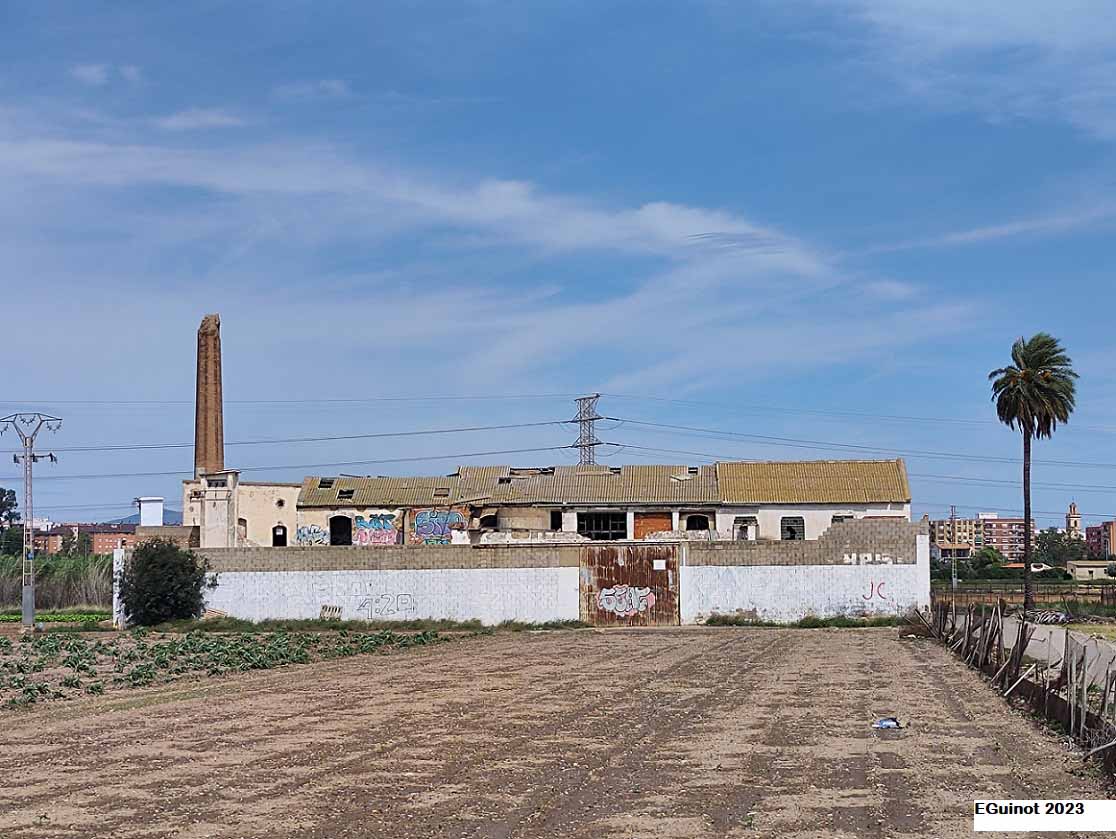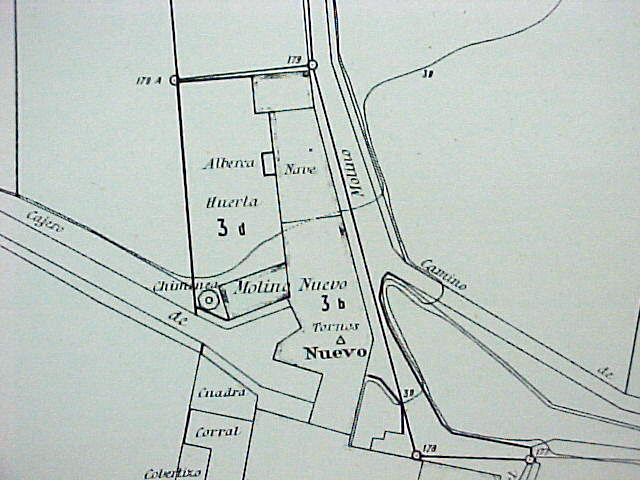
Partida de Dalt, 46, Campanar. It is located on the municipal limits of València and Paterna, near the CV-30. It can be reached by the Partida de Dalt road, both from València (access to the road next to the Campanar cemetery) in the Campanar district, as well as from Paterna.
Based on the data collected in the València City Council's heritage catalogue, both the façade and its coating, as well as the structural slab and the Arabic tile roofs, are in a recoverable state. The machinery has not been conserved and the irrigation canal has been buried underneath.
The mill was originally medieval, dating from the 13th -14th centuries, although the current construction dates from the 17th -18th centuries and was built around the 19th and 20th centuries.
According to Guinot and Selma (2005), it is the first mill in this irrigation canal that has been preserved and has a medieval origin, probably after the 13th century because of the epithet “Molí Nou” (New Mill) in its name. When it became the property of the monastery of nuns of La Saïdia, in the 15th century, its use would be leased every few years to mill-owners. Its presence in the documents is diverse and intermittent: in 1672 it is included in a list of mills of the guild or Confraria de la Pluja de València (Brotherhood of the Rain of València); a century later, in 1771, it is mentioned in the Ordinances of the Mestalla irrigation canal and during the War of Independence, in 1812, works were carried out; in 1827 we know that it was leased to a mill-owner from Campanar, Vicente Llongo i Sancho; in the middle of the 19th century it is also included in the Dictionary that was written by order of P. Madoz and at the end of the same century it is known that a steam engine was installed. At the end of the 20th century, the mill was reconverted into an industry that exploited leather and later cloth until it was completely abandoned at the end of the century.
According to Guinot and Selma (2005) and the heritage catalogue of the PGOU of València (revised in 2013), the transformations of the mill do not allow us to appreciate the original hydraulic constructions that redirected the water from the Mestalla irrigation canal, which reached the mill embedded between fields of crops and entered from the western side, ending up in a small reservoir. However, part of the original façade can still be seen. The current structure of the Molí Nou dates back to the 18th century but with subsequent renovations, especially in the 19th and 20th centuries. The original country house would have had an elongated nave, arranged transversely to the bottom and side of Mestalla irrigation canal, two levels and a gabled roof towards the main façade to the east. Its factory was made of coarse masonry, which was later polished, with the exception of new constructions, built with bricks or with materials such as uralite, used for the roofs. Regarding the hydraulic part, the expansion pond is completely abandoned. The rodets (dismantling joints) have disappeared and the cacaus (stone arches) have had to be adapted to the tubing that was used in the Mestalla irrigation canal at the end of the 20th century. The large chimney, witness to the disappearance of the steam machinery, is located at the back of the mill.
- Plan de Acción Territorial de Protección de la Huerta de Valencia. Versión Preliminar. Memoria de Ordenación. Anexo. Fichas de Elementos de Arquitectura Hidráulica. Índice de Fichas, (dir. Arancha Muñoz), Generalitat Valenciana, 2008, Ficha EPH_10.08, p. 171.
- Revisió simplificada del Pla General de Valencia (2013): Catàleg de Bens i Espais Protegits de natura rural. (EPH-SNU_04.02), pp. 77-80.
- Pla d’Acció Territorial d’Ordenació i Dinamització de l’Horta de València (PAT de l’Horta). Generalitat Valenciana, 2018. Catàleg annex. Element Patrimonial EPH_10.04, pp. 443 - 445.
- Fitxa del catàleg de la Direcció General de Patrimoni Cultural de la Comunitat Valenciana.
GUINOT, E.; SELMA, S. (2005), Les séquies de l’Horta Nord de València: Mestalla, Rascanya i Tormos, Col·leció Camins d’Aigua n. 6, València, Conselleria d’Agricultura de la Generalitat Valenciana, pp. 166-168.
SELMA CASTELL, S. (2014). Paisatges històrics, patrimoni i didàctica. (Les séquies i les hortes del Tribunal de les Aigües de València). Tesi doctoral publicada en PDF. Castelló, Universitat Jaume I de Castelló, pp. 334-336.
ALGARRA PARDO, V. (2014), Vells molins fariners a l’horta de Campanar: massa ombres i alguna llum.
ROSSELLÓ VERGER, V.M (1989): “El molins d’aigua de l’Horta de València,”, dins Los paisajes del Agua), València, Universitat d’Alacant-Universitat de València, p. 317-346.
GUINOT, E.; SELMA, S., LLORIA, R. (2003). El patrimoni hidràulic de les séquies del Tribunal de les Aigües de València. Informe elaborat per a la Direcció General de Patrimoni de la Generalitat Valenciana, Conselleria de Cultura, València.
HERMOSILLA, J. (Coord.). El patrimonio hidráulico del Bajo Turia. L’Horta de València. València, Direcció General de Patrimoni Cultural-Generalitat Valenciana, 2007.
Photos: E.Guinot, Google Earth
























